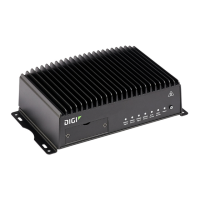Wide Area Networks (WANs) WAN priority and default route metrics
Digi TransPort WR Routers User Guide
57
n cellular2-sim1 (only on models with two cellular modules)
n cellular2-sim2 (only on models with two cellular modules)
To use a cellular interface as a WAN, the cellular interface must be configured to connect to the
cellular network.
See Cellular interfaces.
WAN priority and default route metrics
You can configure up to 10 WANs, named wan1, wan2, wan3, and so on. The WAN number determines
the priority: wan1 is the highest priority, wan2 is the second highest priority, and so on.
When a WAN comes up, the TransPort device automatically adds a default IP route for the WAN. The
metric of the default route is based on the priority of the WAN. For example, because wan1 is the
highest priorityWAN, the default route for wan1 has a metric of 1, and the default route for wan2 has
a metric of 2., and so on.
WAN failover
If a connection to a WAN interface is lost for any reason, the TransPort device will immediately fail
over to the next WANinterface. Two parameters govern the behavior that occurs during the failover
operation:
n The WANinterface's Timeout parameter determines how long the TransPort device will
attempt to connect to the WANinterface before it assumes the interface is unavailable and
fails over to the next WAN interface. Note that once the device has successfully connected to
the WAN and then the connection is lost, it will immediately fail over to the next WAN,
regardless of the Timeout parameter.
n The WAN interface's Retry After parameter determines how long the TransPort device will
wait before attempting to connect to the interface again.
For example, if you configure the WAN1 interface to have a Timeout of 300 seconds and a Retry After
of 1500 seconds:
1. When the TransPort device is restarted, it will attempt to connect to WAN1. If the device fails
to connect to WAN1 after 300 seconds (the value of WAN1's Timeout parameter), it will stop
attempting to connect to WAN1 and attempt to connect to WAN2. The device will then wait for
1500 seconds (the value of WAN1's Retry After parameter) before attempting to connect to
WAN1 again.
Note that if the TransPort device is already connected to WAN1 and the connection fails, the
device will immediately attempt to connect to WAN2.
2. If the connection to WAN2 is not immediately successful, the device will continue to attempt to
connect to WAN2 based for the number of seconds defined for WAN2's Timeout parameter.
3. If the connection to WAN2 also fails, the device will fail over to WAN3. In this case, the device
will continue attempting to connect to WAN1 based on WAN1's Retry After parameter. It will
also continue attempting to connect to WAN2 based on WAN2's Retry After parameter, unless
and until the connection to WAN1 is successful.
The Timeout and Retry After parameters are configured in the Web UI by selecting Network >
Networks > WANs on the menu and expanding the Probing group. See Configure a Wide Area
Network (WAN) for information. The parameters are configured at the command line using the wan
<n> timeout and wan <n> retry-after commands. See the wan command for information.

